Massive cargo ships ferry in and out of the many ports lining the shores from Tokyo to Kawasaki to Yokohama. Surprisingly, these same waters boast a healthy marine ecosystem offering easily accessible sport fishing for inshore and bay area saltwater anglers.

The low tide shoreline at the north side of Tokyo Bay sometimes has a musky smell that reminds you of the immense size and urban density of the city surrounding you. As the boat winds its way through a series of canals and rivers lined with tall apartment complexes, factories and office buildings, first timers can’t believe how close they are to the open ocean.
After reaching the river mouth, it only takes about 30 seconds for those buildings to suddenly get absorbed into the distance. You’re left with a view of the Tokyo skyline complete with all its ubiquitous landmarks, as well the feeling you’re headed for a day of fishing in one of the most unlikely places in the world.
On this day I’m out in a custom built 10-meter center console bay boat with a powerful Yamaha 225-hp. outboard. Four other fishermen and I are starting a five-hour hunt for sea bass – widely considered Tokyo Bay’s most popular game fish.
Our trip will take us to a variety of points near man-made structures such as surf breakers, bridges and docks, as well as natural flats covered by sandy bottom, grass and shell beds. The fish are everywhere, so we could end up casting anywhere.
The Japanese sea bass (lateo-labrax japonicus) is the most prolific sea bass species living in Japan’s coastal waters. Called suzuki in Japanese, these particular sea bass are similar to North American striped bass, snook, European sea bass and other well known sea perches of the world.

Japan’s sea bass fishery is actually one of the most robust in the world for a number of reasons; not the least of which is because it isn’t over pressured by commercial fishermen’s long lines or nets.
Bay area fishing for sea bass using artificial lures has a cadre of avid anglers, many of whom cross over from the ranks of other types of fishing because of the sport’s consistency and tempo.
In other words, the sea bass are always biting somewhere in the bay. The challenge is in knowing how and where to target them–a task anyone can master through experience and the support of good sea bass guides.
The first point where our guide, Capt. Shuzo Kawawa, takes us is a shallow flat just south of Rinkai Park. There are several dozen gulls and cormorants hovering in the distance, occasionally diving at the surface of the water and trying to catch tiny shad minnows.
We can see them splashing here and there, but the sea bass aren’t coming up and striking at the surface. Our guide tells us he sees shad all over his fish-finder, so he reckons the sea bass aren’t active because there’s not a lot of current.
I begin casting my seven-cm. sinking minnow to the shallow side of the point and retrieving it quickly while gently twitching my rod tip. This kind of retrieval often causes what are called “reaction bites” in situations where the bass are not actively feeding.

The idea is a game fish will instantaneously pounce on an erratically darting lure suddenly streaking in front of it. Sea bass will also commonly chase a lure a few meters before striking once they are excited and feeding actively.
After about 10 casts, while not paying attention, I get my first bite right at the edge of the boat as I’m about to lift my minnow out of the water. Slightly shocked, I mistakenly jerk the rod upward; I’m doubly shocked as the 60-cm. sea bass immediately runs towards the surface. In an attempt to compensate for my error, I plunge my rod tip into the water to keep him from jumping and possibly throwing my lure.
Capt. Kawawa yells, “What the hell are you doing, Abdel-san? Don’t let him jump!” He’s scared of the fish busting off, swimming away and spooking the other sea bass that might have chased the lure and which are now excited and in feeding mode. He darts over to me and, inside of two seconds, he’s got a net in the water and is maneuvering in the fish.
Often, when one or two bass switch on and start striking, the entire schools’ predatory instincts will activate, causing them to go into a frenzy. This is what Japanese call iregui (入れ食い) – a situation where an angler can get a bite on almost every cast.
As I’m getting ready to release my sea bass, everyone else on the boat nearly simultaneously hooks up. From then on, we scramble to get our lures back in the water after boating each fish, because we know they’ll calm down and skate out of town if we don’t keep casting.
Next we head to a point east of Odaiba which I’ve passed more times than I can remember, but it looks different every time due to constant construction. This time there are some massive concrete bridge supports where there had been none six months ago.
As an outdoor lover, I have a love-hate feeling about places such as these becausem although unattractive, the temporary piers, platforms and barges surrounding these construction sites are prime real estate for sea bass. Today there are patrol boats and buoys marking the area off-limits, so to our disappointment we have to fish out in the open.
Just north of the construction site, we cast some heavier vibration lures which swim deeper to target bass holding closer to the bottom. Capt. Kawawa sees a lot of them on his fish-finder, but we’re only getting intermittent bites.
The setting sun, quickly dropping temperature, lack of current and bait fish could mean the sea bass are going to be inactive for a bit. After casting for about 30 minutes, we give up and head for the mouths of the Ara and Edo rivers where there will at least be some current keeping the fish excited. For our last melee with the sea bass, we stop under a few bridges to cast near and between pilings where the fish gather for safety and easy pickings of any baitfish passing by. Casting on these points requires accuracy and coordination, because the spaces where the sea bass will strike are pretty narrow.
After dark, the most effective way to fish is to slowly retrieve the lure along the border between shadows cast by the bridges and the areas illuminated by the street lights above. Sea bass line up just inside the shaded areas waiting for prey to swim by.
Although I’ve only recently begun fishing bridges in Japan this way, I’m getting a lot of bites and nabbed one or two fish longer than 50 cm.
“Hey, Abdel-san, you’re getting better at this aren’t you?” Capt. Kawawa shouts. For all my years in Japan, I still don’t know how to take compliments humbly, so I shoot back, “Damn right!” He beams at me with a “sasuga, gaijin da-ne” type of smile. At about 6:30 p.m. it’s lines in and back to the dock.
I’m hoping to break my personal sea bass record of 87 cm. by the end of the year, but I’ll be satisfied with any lunkers I catch along the way. On any given trip, it’s possible to pull up several fish bigger than 70 cm., but most anglers dream of the day they can enter the “90 Over Club.”
I’m sure I’ll get there with a little patience and have a great time while I’m at it.
Fishing Tips
Readers interested in Tokyo Bay sea bass angling can get their feet wet any time of year with one of several dozen guides operating from points all around Tokyo Bay.
Capt. Kawawa’s outfit, which I highly recommend, is called Kaido (海道) and operates three boats launching from the Naka River in Edogawa Ward. He has rods for those without tackle and a wealth of knowledge for novice and experienced anglers alike.
You can also check out my site for info on sea bass and other types of sport fishing in Japan.





